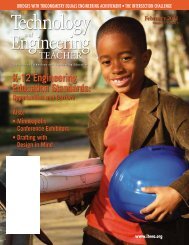Vol 66, No. 7 - International Technology and Engineering Educators ...
Vol 66, No. 7 - International Technology and Engineering Educators ...
Vol 66, No. 7 - International Technology and Engineering Educators ...
Create successful ePaper yourself
Turn your PDF publications into a flip-book with our unique Google optimized e-Paper software.
about taking on this challenge? How do you envision solving<br />
this very real, very practical problem?<br />
What a great segue for learning about airplanes, airports,<br />
aeronautical engineering, <strong>and</strong> the science of moving people<br />
efficiently <strong>and</strong> safely through time <strong>and</strong> space.<br />
<strong>and</strong> people? Is there anything similar to this concept, say,<br />
from the railroads, trucking, <strong>and</strong> freight hauling industries<br />
that might be borrowed or adapted? Can the loading<br />
of passengers be modularized? What might happen if a<br />
passenger <strong>and</strong> his/her seat are already a distinct module<br />
before they even get on the plane? Could the seat <strong>and</strong><br />
person sitting in it simply move to the proper location on<br />
the plane…automatically? Maybe your carry-on<br />
baggage is stored under the seat you are sitting in, <strong>and</strong> no<br />
overhead storage is allowed at all. Can you visualize what<br />
this change in perspective might do to airliner design <strong>and</strong><br />
loading efficiency?<br />
Harry T. Roman recently retired from his<br />
engineering job <strong>and</strong> is the author of a variety<br />
of new technology education books. He can<br />
be reached via email at htroman49@aol.<br />
com.<br />
Think about this: A train is nothing more than a collection<br />
of cars that are connected together for a specific purpose<br />
<strong>and</strong> for a certain length of time. The train is assembled<br />
in a modular <strong>and</strong> somewhat automated fashion, <strong>and</strong><br />
disassembled the same way. Can this concept be adapted to<br />
the airline industry?<br />
What might happen to the layout of airports if such<br />
sweeping changes were made to airplane design? How<br />
do you think this might affect the way that aeronautical<br />
engineers design airplanes? What would you be concerned<br />
about if the plane came in separate sections that could be<br />
preassembled <strong>and</strong> then loaded or slid into place just<br />
before takeoff?<br />
This is a multi-dimensional problem challenge that<br />
everyone in the class can identify with, <strong>and</strong> should be able<br />
to reasonably consider. It is certainly a challenge that would<br />
lend itself to a team-based approach.<br />
Maybe the solution set here is to first improve the existing<br />
process <strong>and</strong> then redesign the modern jet airliner. I wonder<br />
what airline companies have on the drawing board. Airliners<br />
originally only had one level, <strong>and</strong> now the super jumbo<br />
variety have multiple levels. They once only had a single<br />
aisle; <strong>and</strong> now they have multiple aisles on wide-body<br />
models. Reality often starts with dreams that are eventually<br />
made technically, economically, environmentally, <strong>and</strong><br />
socially acceptable. So what do you <strong>and</strong> your students think<br />
• The <strong>Technology</strong> Teacher • april 2007
















